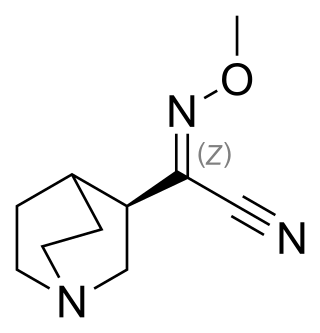
Acetylcholine (ACh) is an organic compound that functions in the brain and body of many types of animals as a neurotransmitter. Its name is derived from its chemical structure: it is an ester of acetic acid and choline. Parts in the body that use or are affected by acetylcholine are referred to as cholinergic.

Muscarine, L-(+)-muscarine, or muscarin is a natural product found in certain mushrooms, particularly in Inocybe and Clitocybe species, such as the deadly C. dealbata. Mushrooms in the genera Entoloma and Mycena have also been found to contain levels of muscarine which can be dangerous if ingested. Muscarine has been found in harmless trace amounts in Boletus, Hygrocybe, Lactarius and Russula. Trace concentrations of muscarine are also found in Amanita muscaria, though the pharmacologically more relevant compound from this mushroom is the Z-drug-like alkaloid muscimol. A. muscaria fruitbodies contain a variable dose of muscarine, usually around 0.0003% fresh weight. This is very low and toxicity symptoms occur very rarely. Inocybe and Clitocybe contain muscarine concentrations up to 1.6%.

A muscarinic agonist is an agent that activates the activity of the muscarinic acetylcholine receptor. The muscarinic receptor has different subtypes, labelled M1-M5, allowing for further differentiation.

Gaboxadol, also known as 4,5,6,7-tetrahydroisoxazolo(5,4-c)pyridin-3-ol (THIP), is a conformationally constrained derivative of the alkaloid muscimol that was first synthesized in 1977 by the Danish chemist Poul Krogsgaard-Larsen. In the early 1980s gaboxadol was the subject of a series of pilot studies that tested its efficacy as an analgesic and anxiolytic, as well as a treatment for tardive dyskinesia, Huntington's disease, Alzheimer's disease, and spasticity. It was not until 1996 that researchers attempted to harness gaboxadol's frequently reported sedative "adverse effect" for the treatment of insomnia, resulting in a series of clinical trials sponsored by Lundbeck and Merck. In March, 2007, Merck and Lundbeck cancelled work on the drug, citing safety concerns and the failure of an efficacy trial. It acts on the GABA system, but in a different way from benzodiazepines, Z-Drugs, and barbiturates. Lundbeck states that gaboxadol also increases deep sleep. Unlike benzodiazepines, gaboxadol does not demonstrate reinforcement in mice or baboons despite activation of dopaminergic neurons in the ventral tegmental area.

A muscarinic receptor antagonist (MRA), also called an antimuscarinic, is a type of anticholinergic agent that blocks the activity of the muscarinic acetylcholine receptor. The muscarinic receptor is a protein involved in the transmission of signals through certain parts of the nervous system, and muscarinic receptor antagonists work to prevent this transmission from occurring. Notably, muscarinic antagonists reduce the activation of the parasympathetic nervous system. The normal function of the parasympathetic system is often summarised as "rest-and-digest", and includes slowing of the heart, an increased rate of digestion, narrowing of the airways, promotion of urination, and sexual arousal. Muscarinic antagonists counter this parasympathetic "rest-and-digest" response, and also work elsewhere in both the central and peripheral nervous systems.
A nicotinic agonist is a drug that mimics the action of acetylcholine (ACh) at nicotinic acetylcholine receptors (nAChRs). The nAChR is named for its affinity for nicotine.

GTS-21 is a drug that has been shown to enhance memory and cognitive function. It has been studied for its potential therapeutic uses, particularly in the treatment of neurodegenerative diseases and psychiatric disorders.

Xanomeline is a small molecule muscarinic acetylcholine receptor agonist that was first synthesized in a collaboration between Eli Lilly and Novo Nordisk as an investigational therapeutic being studied for the treatment of central nervous system disorders.

Pimavanserin, sold under the brand name Nuplazid, is an atypical antipsychotic which is approved for the treatment of Parkinson's disease psychosis and is also being studied for the treatment of Alzheimer's disease psychosis, schizophrenia, agitation, and major depressive disorder. Unlike other antipsychotics, pimavanserin is not a dopamine receptor antagonist.

Alvameline (Lu 25-109) is a M1 receptor agonist and M2/M3 receptor antagonist that was under investigation for the treatment of Alzheimer's disease, but produced poor results in clinical trials and was subsequently discontinued.

Sabcomeline (Memric; SB-202,026) is a selective M1 receptor partial agonist that was under development for the treatment of Alzheimer's disease. It made it to phase III clinical trials before being discontinued due to poor results.

Tazomeline (LY-287,041) is a drug which acts as a non-selective muscarinic acetylcholine receptor agonist. It was in clinical trials for the treatment of cognitive dysfunction such as that seen in Alzheimer's disease and schizophrenia, but development was apparently scrapped for unknown reasons. Another of the patented uses is for the treatment of "severe painful conditions".

Talsaclidine (WAL-2014) is a non-selective muscarinic acetylcholine receptor agonist which acts as a full agonist at the M1 subtype, and as a partial agonist at the M2 and M3 subtypes. It was under development for the treatment of Alzheimer's disease but showed only modest or poor efficacy in rhesus monkeys and humans, respectively, perhaps due to an array of dose-limiting side effects including increased heart rate and blood pressure, increased salivation, urinary frequency and burning upon urination, increased lacrimation and nasal secretion, abnormal accommodation, heartburn, upset stomach as well as cramps, nausea, vomiting and diarrhea, excessive sweating and palpitations.
CI-1017 is a muscarinic acetylcholine receptor agonist which is selective for and is approximately equipotent at the M1 and M4 receptors, with 20-30-fold lower affinity for the M2, M3, and M5 subtypes It is the (R)-enantiomer of the racemic compound PD-142,505.

Brexpiprazole, sold under the brand name Rexulti among others, is a medication used for the treatment of major depressive disorder, schizophrenia, and agitation associated with dementia due to Alzheimer's disease. It is an atypical antipsychotic.

Blarcamesine is an experimental drug developed by Anavex Life Sciences.
Autonomic drugs can either inhibit or enhance the functions of the parasympathetic and sympathetic nervous systems. This type of drug can be used to treat a wide range of diseases, such as glaucoma, asthma, urinary, gastrointestinal and cardiopulmonary disorders.

Huprine X is a synthetic cholinergic compound developed as a hybrid between the natural product Huperzine A and the synthetic drug tacrine. It is one of the most potent reversible inhibitors of acetylcholinesterase known, with a binding affinity of 0.026nM, as well as showing direct agonist activity at both nicotinic and muscarinic acetylcholine receptors. In animal studies it has nootropic and neuroprotective effects, and is used in research into Alzheimer's disease, and although huprine X itself has not been researched for medical use in humans, a large family of related derivatives have been developed.

AC-42 is a selective, allosteric agonist of the M1 muscarinic acetylcholine receptor. AC-42 was the first selective M1 agonist to be discovered and its derivatives have been used to study the binding domain of the M1 receptor.
Xanomeline/trospium, also known under the brand name KarXT, is an investigational oral dual-drug fixed-dose combination of xanomeline and trospium. It is undergoing a phase 3 clinical trial for the treatment of schizophrenia. Xanomeline is a functionally preferring muscarinic M4 and M1 receptor agonist that readily passes into the central nervous system (CNS) to stimulate these receptors in key areas of the brain. Trospium is a non-selective muscarinic antagonist that does not cross into the CNS and reduces peripheral cholinergic side effects associated with xanomeline.















